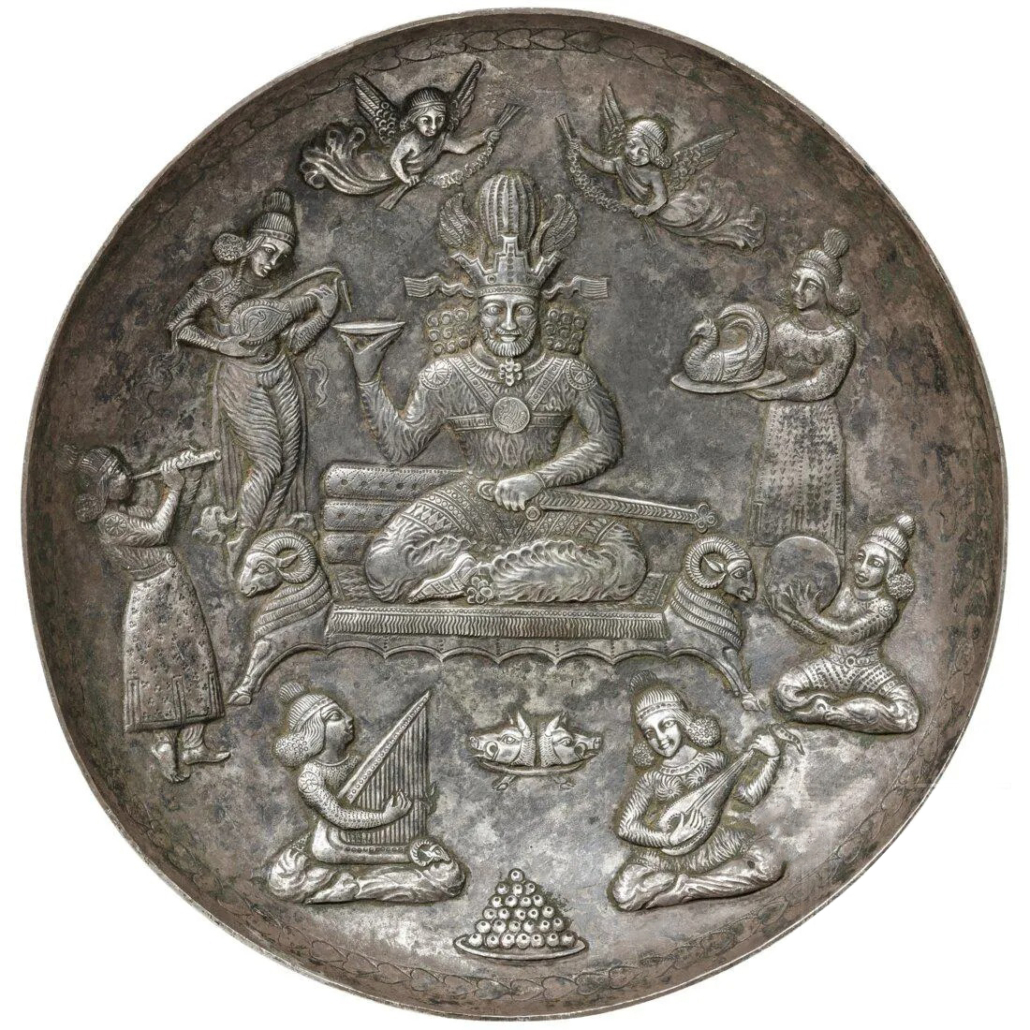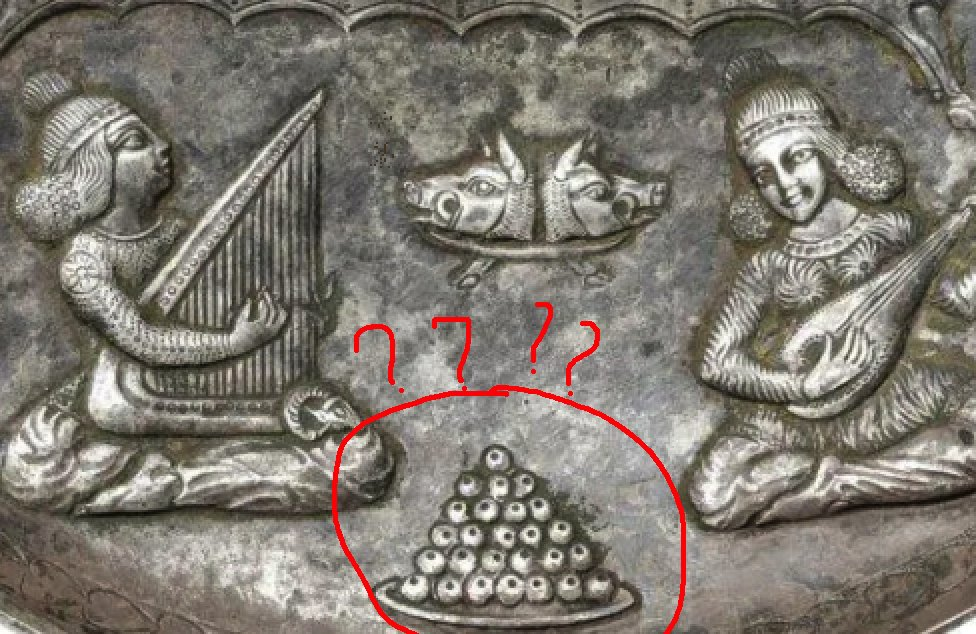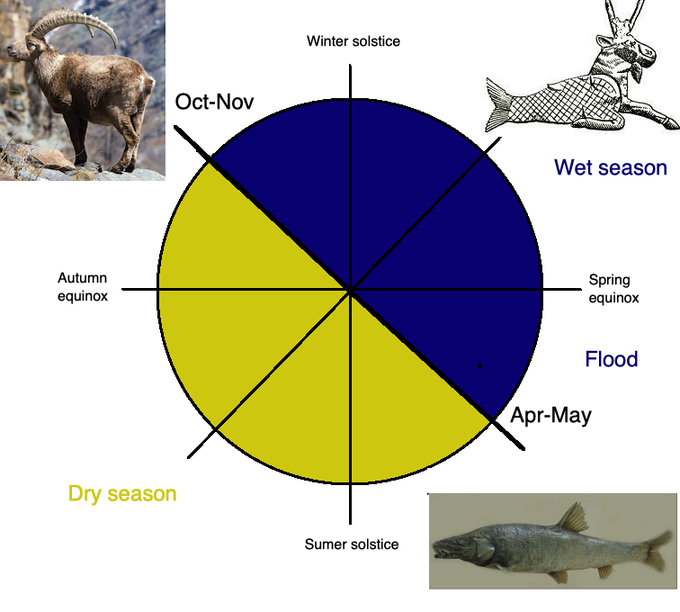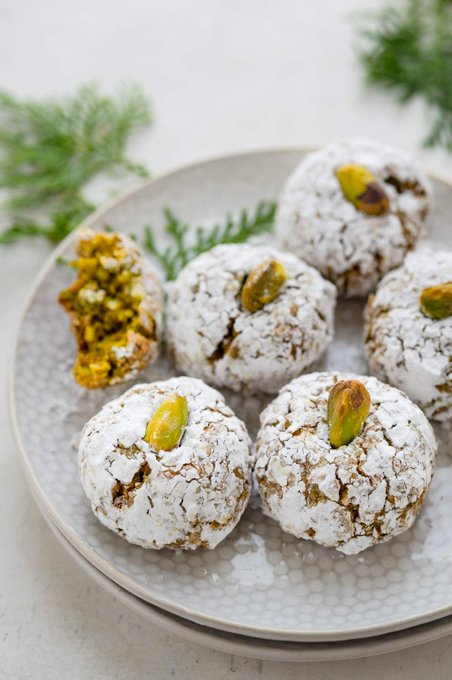I while back I came across this late 6th or early 7th c. AD Sassanian silver bowl.
It shows a king sitting on a throne, feasting, surrounded by musicians and servants. We can see a platter with two boar heads in front of the throne and...What the hell is this??? A plate of eyeballs??? 🙂
I suggested that these were not in fact eyeballs, but Naan Gerdooee ~ Persian Walnut Cookies, or some similar type of pastry
Then, @Nazdorove posted a comment to my post reminding me of animal and plant calendar markers 🙂 and telling me that maybe I should check this plate and see if any are present in the depicted scene...Maybe that could help us determine what the mystery balls stacked on the plate are...
So I looked at the scene more carefully, and, I could see something very interesting: The "king" was seated on a throne whose legs are shaped like rams...
And the harp played by one of the musicians also has a ram's head. Why? I think this is a ceremonial throne and a ceremonial harp...What ceremony are we talking about here? Well...Ram...Aries...Arrives after Spring Equinox...Nowruz...Persian New Year...
Kind of an important event in the Persian calendar...Actually, the most important event...Ram is the animal calendar marker for spring, cause it is in the spring that sheep lambing season takes place...
This is why Aries marks Mar/Apr. Cause this is when the lambing season ends and milking season starts and the flocks are moved to the highland pastures. I talked about this in my posts "April" and "Aries must die"...
Why are these animals found as symbols of the seasons in Eurasia and North Africa, since Neolithic, despite Precession? I talk about it in my post "Symbols of seasons"...
But in Iran, one more thing happens in Mar/Apr...The river discharges suddenly start to increase, as a result of spring rains and snowmelt.
Hence Ram depicted lying in water from the "Zodiac from Isfahan". I talked about it in my post "Sagittarius from Isfahan"...
BTW, we find the same animal calendar marker, with the same meaning, in Ancient Mesopotamia too...Goatfish marks the wet half of the year, from the start of the mating season of ibex goats (Oct/Nov) to the start of the mating season of giant Mesopotamian carp (Apr/May) which is when the annual flood peaks.
The water level in Tigris and Euphrates starts to increase in Mar/Apr, when wild sheep lamb season ends. I talked about this in my post "Goatfish with ram head"
The "King" sitting on the ram throne is having drink poured into his chalice...This could be wine, which becomes ready for drinking at the end of spring, beginning of summer (Mar/Apr/May)...Right on time for New Year festival...Or it could be water...Symbolically depicting flowing water season...
The other servant is bringing a platter, with what looks like a cockerel, with all its feathers...Definitely not intended to be food...
If it is a cockerel, then it's another animal calendar marker for Mar/Apr.
Europe...
Cockerel was the sacred bird of Perun, Slavic thunder god, used in magic rituals for protection agains lightning.
Why? Maybe cause chicken main mating season is during the period of 14+ daylight hours.
Which is the main thunderstorm season in Europe??? I talked about this in my post "Pero"...
India
Red junglefowl (Gallus gallus), the ancestor of the domestic chicken...
Has a fixed annual mating season, which overlaps with the Zebu cattle mating season...
Hence, on Indus Valley civilisation pot, it is placed on the Zebu bull's back...I talked about this in my post "Kharif and Rabi season"...
China...
The real reason why The Lord of Thunder, was depicted as a cockerel is because of the China's latitude and the reproductive cycle of wild chickens, which is governed by the amount of sunlight, and at China's latitude starts in Apr/May...
Which is when the thunderstorm season starts too...
I talked about this in my post "Lei Kung"...
Interestingly, the platter placed before the "King" sitting on his Ram (spring) throne, contains two Boar heads (winter)...
Wild boar is one of the symbols of winter...Cause they mate during the winter...I talked about this in my posts: "When fish swim up Danube", "Achaemenid lion boar seal", "Souvetaurilia", "Sirens", "Summer and winter BMAC seals"...
So how can any of this help us to figure out what is on the front platter? We all know these are not eyeballs 🙂 I was joking...But what are they?
Fruit? Most people suggested pomegranates, which originate in Iran. But pomegranates season is winter...Not spring...
The fruits which are in season during Nowruz (Persian New Year festival) are bitter oranges (narenj). These things...
They are used for making sirups and in cooking and are not eaten as fruit...
So what are these round things neatly piled on the platter? I went to see what traditional cookies are made for Nowruz, and this pic popped out 🙂 Toot, Persian Mulberry Marzipan Candy...Looks familiar? 🙂
Today it's made with sugar, but originally it could have been made with crushed nuts, dates and honey...Similar to these Italian pistachio cookies...
And so...Thanks to @Nazdorove we might have solved the mystery of the "eyeballs" platter...What do you think?



























No comments:
Post a Comment